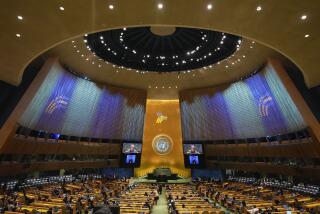THE REYKJAVIK SUMMIT : Split at Talks Reflects Dispute Over Meaning of 1972 ABM Pact
- Share via
WASHINGTON — When President Reagan and Soviet leader Mikhail S. Gorbachev ended their summit in Reykjavik, Iceland, on Sunday in disagreement over U.S. anti-missile programs, their dispute reflected a long-running debate over the precise meaning of the 1972 Anti-Ballistic Missile (ABM) Treaty.
Neither side made public the precise wording of its latest proposals, but Reagan and Gorbachev, in equally emotional statements, said they failed to agree on a wide range of arms control measures because of their unbridgeable differences over the U.S. space-based missile defense program officially known as the Strategic Defense Initiative and popularly called “Star Wars.”
According to Secretary of State George P. Shultz, Gorbachev proposed amendments to the 1972 ABM treaty that would have limited the Strategic Defense Initiative to laboratory research for 10 years. Shultz said such restrictions would prevent the program from proceeding “at all forcefully” and were unacceptable to the United States.
By proposing changes in the treaty, Gorbachev implicitly conceded that the treaty as presently written will not prevent the U.S. program.
The treaty, signed by former President Richard M. Nixon and former Soviet leader Leonid I. Brezhnev at their summit in Moscow, consists of 16 articles, making it relatively brief for a pact governing the war-and-peace behavior of the superpowers.
Not ‘Develop, Test, Deploy’
In Article 5, the United States and the Soviet Union agree “not to develop, test or deploy ABM systems or components which are sea-based, air-based, space-based or mobile land-based.”
For years, the U.S. government accepted what was then the conventional interpretation of the treaty as an absolute ban on development and testing of space-based and mobile anti-missile systems.
However, last year Pentagon and State Department lawyers concluded that the treaty did not ban the development and testing of defensive systems based on “new physical concepts.” The lawyers determined that the United States had proposed a ban on exotic weapons during negotiations of the treaty but that the Soviets had refused.
The treaty’s second article defines ABM systems in terms of the technology known in 1972, something which convinced the Pentagon and State Department lawyers that newer technologies such as the Strategic Defense Initiative were not included.
Robert C. McFarlane, then White House national security adviser, disclosed the new interpretation Oct. 6, 1985, when he was interviewed on the NBC-TV program “Meet the Press.”
The interpretation was instantly controversial. The Soviets said that the U.S. program, if carried out, would be a violation of the ABM treaty. Gerard C. Smith, the chief U.S. negotiator in the talks that produced the treaty, complained that the interpretation would gut the entire treaty. And many of the European members of the North Atlantic Treaty Organization opposed the reinterpretation.
In response to the NATO criticism, Shultz announced later that October that Washington would continue to abide by a “narrow” interpretation of the treaty even though it considered the “broader” one to be totally justified. Nevertheless, the secretary said, the narrow interpretation was broad enough to cover the testing the United States planned to do.
At a press briefing Sunday in Reykjavik, Shultz was asked if the United States had reverted to the broad interpretation of the pact.
“That was not the issue,” he said. “The issue was a proposal to change the ABM treaty, not to interpret it in any particular way, but to change it in such a manner that research would be confined to what you could do in a laboratory. That’s a change.”
The ABM treaty and the treaty prohibiting all but underground nuclear tests are the only arms control pacts that the superpowers have ever signed which did not include expiration dates. The first strategic arms limitation treaty, or SALT I, signed in 1972, and its unratified successor, the 1979 SALT II pact, both covering offensive nuclear weapons, have long since expired.
Kept SALT II Limits
Both sides agreed, for a time, not to “undercut” the agreed limits of SALT II. However, Reagan announced last spring that the United States would no longer be bound by the terms of the agreement, since, he asserted, Moscow had violated them repeatedly,
The United States has also maintained that the Soviets have violated the ABM treaty by building a giant radar complex in Siberia. Neither side, however, has said that it will pull out of the pact because of what it considers violations by the other.
The ABM treaty limited each side to two anti-missile systems, consisting of no more than 100 launcher rockets and located in an area with a radius of about 100 miles. One system could be deployed to protect the national capital and the other to defend an offensive missile base. Later, Washington and Moscow agreed to reduce the limit to one system.
The Soviet Union maintains an ABM system around Moscow. The United States maintains that the new radar complex in Siberia is a violation of the treaty because it is part of what could be a system protecting the entire country, which the treaty forbids.
The United States installed one anti-missile system around an intercontinental ballistic missile field but later dismantled it because it was not considered to be cost effective.
More to Read
Sign up for Essential California
The most important California stories and recommendations in your inbox every morning.
You may occasionally receive promotional content from the Los Angeles Times.












